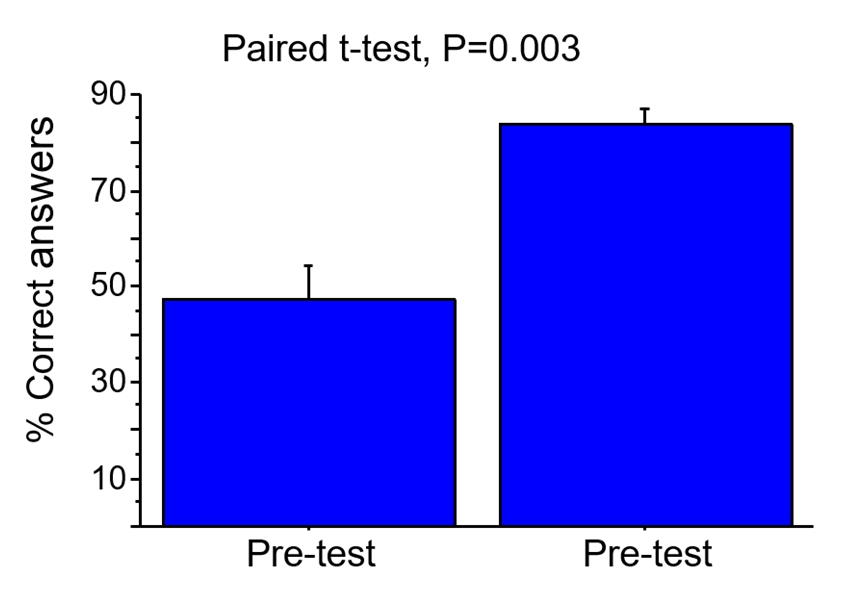Teaching honey bees to beekeepers and general public
Jan 15, 2021
Zachary Huang, Michigan State University
Preamble
Honey bees (Apis mellifera) are by far the most beneficial insects because of the billions of dollars worth of crops they pollinate. In Michigan alone, the value of fruits and vegetables that depend on honey bee pollination is nearly $1 billion per year. Yet honey bees are often plagued by various types of stresses, such as parasites, pathogens, pesticides, poor nutrition and movement of bee colonies across the country. Many new people are getting into beekeeping due to the recent news surge of “CCD” (colony collapse disorder) and Michigan has close to 1,000 registered members for the Michigan Beekeepers Association. Because our state does not have mandatory registration, the estimated number of beekeepers in our state should be close to 2,000, if not more. Although my main target audience are Michigan beekeepers I have also reached other beekeepers through regional and national beekeeping organizations and through the websites. In the following I summarize the extent of my extension/outreach efforts.
Extension talks
Table 1 below shows the total number of talks and the number of audiences reached through in person talks for the last 22 years (Jan 1999 to Dec 2020). I am one of the founding directors for the Midwest beekeeper association, HAS (Heartland Apicultural Society) which is the one of the three regional beekeeper associations in the country (with EAS, and WAS). I missed only 2-3 meetings since its inception in 2002. I also contribute to present at EAS whenever possible and also presented at national meetings such as ABF or AHPA, or their joint meetings.
| Michigan | Regional/ Out State | International | ||
| Person/hours | 18918 | 6965 | 4838 | 30721 |
| Number of presentations | 190 | 91 | 54 | 335 |
International reach
Besides many trips made to China and some workshops to beekeepers there, I have made three trips to three other countries: Nepal (2007), Haiti (2011) and Bangladesh (2012). Each trip was for 2 weeks and sponsored by the USAID’s Farmer to Farmer program. I taught general beekeeping, disease management, queen rearing, honey production, honey marking, royal jelly production and varroa mite control to beekeepers in each country. It was my intension to help undeveloped countries using my expertise and it was a greatly satisfying experience in doing this. This counts very little in the academia system I work, but I consider it important to do so.
Reaching out through websites
1. cyberbee.net was originally a hub for information, created in 1997 before I started at the Michigan State University. It was mentioned in the journal “Science” as the “Best pick” for information related to honey bees in 2001. Since then I have changed it to a gallery of photos mainly for beekeepers, but also for extension apiculturists, providing information on bee anatomy, honey bee disease photos, package bee installation, etc. It has a total hit count of 5,297,896 (as of Jan 22, 2021) with over 2000 photos. It is quite satisfying to go to a meeting and find one out of five speakers would be using my photos (some unknowingly). My photos are also published widely as covers for bee journals (Bee Culture, American Bee Journal) and as covers or inside honey bee books (Covers: Honey bee biology and beekeeping, Honey bee hobbyist; inside books: the Hive and Honey Bee, and a recent book by Thomas Seeley, “The Lives of Bees: The Untold Story of the Honey Bee in the Wild”). All photos published as covers are at: http://ww2.beetography.com/index.php/Contests/Covers-and-others
- ww2.beetography.com was created to show honey bees (mostly Apis mellifera, followed by A. cerana, and some A. dorsata and A. florea) foraging on different plants, as ecological records of what plants honey bees forage on. I started the project about 10 years ago and have been updating the website slowly. I thought it would be “selfish” to keep the photos in my computer. Furthermore, if an accident was to happen to me, nobody else will be able to process the photos and make them available to the public. Currently the site has about 220 species of plants foraged by A. mellifera and 40 species by A. cerana. More details are provided below in Table 2. Providing such a graphical database of what plants are attractive to honey bees is of great help to beekeepers for understanding what plants are good for honey bees.
Table 2. Number of albums (species), images and views since inception at http://ww2.beetography.com
| Species | Albums | Images | Views |
| mellifera | 225 | 1630 | 246,732 |
| cerana | 40 | 271 | 42,937 |
| dorsata | 3 | 47 | 10,795 |
- eXension.org articles
I have written several highly popular articles on eXtension.org. For example, honey bee anatomy and honey bee nutrition had pageviews of 13,150 and 11,564 page views, respectively (2018 to 2020). Varroa mite reproductive biology is highly read by beekeepers, judging from searching within websites such as http://beeresource.com and http://beekeepingforum.co.uk.
The Table below has some old stats I have (The new stats are available only for the last year or so).
Table 3. Pageviews of my articles eXtension.org. * indicates ranking of top 7 and 8 out of 5442 topics on eXtension.org. New stats based on google analytics (installed Oct 8, 2019)
| Title | Publication to 4.1.2013 | 10.8.2019 to 1.23.2021 |
| Huang 2012. Varroa mite reproductive biology. | 1886 | 5,615 |
| Huang 2011. Effects of Nosema on honey bee behavior and physiology. | 2,884 | 716 |
| Huang 2010. Honey bee nutrition. | 5,780 | 11,593* |
| Huang 2010. Anatomy of the honey bee. | 22,773 | 13,173* |
| Huang 2010. Bees and social insects. | 4,136 | 2,104 |
- bees.msu.edu blogs
I blogged on more than 40 species of flowers so far (https://bees.msu.edu/flowers/), ranking their attractiveness to honey bees and with beautiful images of bees foraging on each major nectar/pollen plants. Below are the top ranking blogs on my site. I installed pageview counters around August 1st, 2020, so these stats are from 8.1.2020 to 1.11.2021.
Table 3. Pageviews of most popular blogs on http://bees.msu.edu/flower.
| Title | Pageviews since Aug. 1, 2020 |
| Checking your varroa in the fall | 445 |
| Summer flower 3: basswood | 329 |
| Bees foraging on catalpa leaves | 319 |
| Summer flower 4: Stahorn sumac | 318 |
| Summer flower 11: Red clover | 314 |
| Summer flower 5: Bird’s foot trefoil | 290 |
| Spring flower 20: Honeysuckle | 287 |
| Spring flower 24: Peonies | 256 |
| Bees foraging on lotus | 254 |
| Spring flower 21: Tulip | 252 |
In addition, I host the Michigan Beekeeper Association website (michiganbees.org), which averages 336 page views and 156 unique visits per day. I post there regularly about honey bee plants and bee biology. With the exception of bees.msu.edu (hosted on a MSU server), all other websites (michiganbees.org, ww2.beetography.com, aapa.cyberbee.net, iussi.cyberbee.net) I host on outside servers using my own money. Aapa.cyberbee.net is a website for American Association of Professional Apiculturists and iussi.cyberbee.net is one for the International Union of Social Insects.
Impact Assessment
How effective was my teaching to beekeepers? Especially considering some of the presentations are highly technical. So I did pre and post tests for some of my talks during the recent years.
2018 data: I did pre and post tests at the ANR week (mite biology) and a queen rearing class (queen biology) (Fig 1 below). In both cases, the % correct scores went from below 60% to over 92%, showing significant improvement in their understanding of both mite and queen biology.

Fig. 1. Mean (+SE) of percent correct answers for pre (grey) and post (blue) tests for a mite biology class (left, N=22) and a queen biology class (N=12). Paired t-tests showed both to be significant different.
2019 data: I did pre and post tests at the 2019 ANR week (mite biology, figure below). The % correct scores went from below 50% to over 85%, showing significant improvement in their understanding of both mite biology (P<0.01).

Fig. 2. Mean (+SE) of percent correct answers for pre (left) and post (right) tests for the honey bee anatomy class (N = 6, out of a total of 21 students). Paired t-tests showed the two scores to be significantly different.

